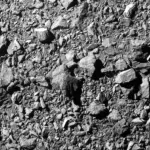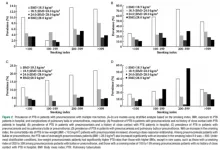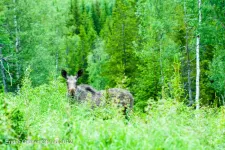(Press-News.org) Researchers from the University of Copenhagen and NASA have developed a method that has now mapped several billion trees and their carbon uptake in Africa’s Sahel region. In the future, the method could be used to monitor whether climate credit purchases have a positive effect on the number of trees and whether nature restoration is working.
The purchase of indulgences for CO2 emissions is gaining steam among global corporations. Carbon offset credits allow companies to emit a given amount of CO2 in exchange for the greenhouse gas being neutralized elsewhere, in the form of trees planted or left unfelled.
But with billions upon billions of trees across the planet, keeping track of how many are added and how many are disappearing is tough, to say the least. Now, researchers from the University of Copenhagen’s Department of Geosciences and Natural Resource Management and Department of Computer Science, in collaboration with the American space agency NASA, have pioneered a method that makes it possible to count the number of trees across vast swaths of land and calculate how much carbon is sequestered within each tree.
The study has just been published in the scientific journal, Nature. The method allowed the researchers to count 9.9 billion trees and measure how much carbon is stored in the semiarid Sahel, a belt of land stretching across Northern Africa, from the Atlantic to the Red Sea. The region of analysis covered roughly 10 million square kilometers.
According to Professor Rasmus Fensholt, who played a key role in the research, the new method can be an important tool for companies when they and others want to pay for their emissions – either in the form of newly planted trees or by paying farmers not to cut down trees on their land.
"There are many indications that carbon credit trading will become more and more extensive in the future – not just for earth's forests, but for billions of trees beyond forests. Therefore, it is critical for us to be able to monitor whether carbon trading reflects the actual number of trees in nature and whether it has a positive effect on climate. This is what we are coming with a solution to," he says.
A 300,000-piece satellite image puzzle
Collaborating with NASA, the researchers gained access to 300,000 very-high-resolution satellite images of Africa’s Sahel region. The images were reviewed and pieced together in a mosaic that shows the number of trees from above. Using artificial intelligence, they then trained one of NASA's supercomputers to identify all individual trees – for example, acacia based on their flat crowns.
"Our study demonstrates that deep learning techniques can revolutionize the global mapping of individual trees and their biomass. Our artificial neural networks learn to extract complex patterns from large amounts of satellite images, allowing for more accurate and efficient identification of individual trees and subsequent estimation of their biomass," says professor Christian Igel, Department of Computer Science.
The mapping shows that the Sahel, one of the world's driest regions without being outright desert, is home to nearly 10 billion trees. These trees currently store 840,000,000 tons of carbon according to the researchers' measurements, a number based on the weight of individual trees.
"We have done a lot of fieldwork, weighing trees when they are cut down to collect data on the amount of carbon they contain. We combined this with the satellite images of the number of trees and the size of individual tree crowns and fed it all into a larger model," explains Fensholt.
Ability to monitor tree planting
Besides helping to control the effect of climate credits, the method can also be used to investigate whether various nature restoration projects with trees in regions such as the semiarid Sahel, among others, are actually going as they should.
"Over the past 10-15 years, considerable resources have been spent on large-scale tree planting projects in arid regions of the world, including those financed by the World Bank. Have they worked? Have the trees survived? Our method can be used to help map this," says Rasmus Fensholt, adding that the next research project in the pipeline will be to look at how the number of trees has evolved over past decades.
At the same time, current international inventories of global tree-sequestered carbon are subject to great uncertainty. By mapping the carbon content of trees individually, as the researchers did in the Sahel, it is possible to gain a far more accurate and better basis for understanding the impact of human and climate-induced impacts on our ecosystems. Ultimately, this work also helps us create more accurate climate models that allow us to predict what to expect in the future.
According to the researcher, the groundwork is done and the method is ready to be deployed in the near future by public agencies, NGOs and others interested in monitoring tree tallies and their carbon content.
The research was conducted in close collaboration with colleague’s associate professor Martin Brandt, Department of Geosciences and Natural Resource Management and postdoc Ankit Kariryaa, Department of Computer Science.
Facts:
In a new study published in Nature, researchers from the University of Copenhagen’s Department of Geosciences and Natural Resource Management and Department of Computer Science, together with a number of international research institutions, mapped 9.9 billion trees in North Africa’s Sahel, one of Earth's driest regions.
The study area, encompassing the Sahel region, stretches across the south-central latitudes of Northern Africa, from the Atlantic Ocean in the West to the Red Sea in the east, covering an area of 10 million square kilometers.
The researchers also calculated the amount of carbon stored by the region’s trees: 840,000,000 tons.
The study was carried out by compiling more than 300,000 satellite images from NASA, which were subsequently analyzed by a supercomputer.
The researchers developed an artificial intelligence algorithm that allows the supercomputer to discern among the different tree species of the Sahel using satellite imagery.
Through fieldwork on the ground, the researchers were able to characterize thirty different tree species and develop a database showing wood, root and foliage mass, as well as carbon content per tree.
Contact:
Rasmus Fensholt
Professor
Department of Geosciences and Natural Resource Management
The Faculty of Science
University of Copenhagen
Phone: +45 35322526
rf@ign.ku.dk
Michael Skov Jensen
Journalist and team coordinator
The Faculty of Science
University of Copenhagen
Mobile: + 45 93 56 58 97
msj@science.ku.dk
END
The counting of nine billion trees could help manage climate credits and nature restoration
Researchers from the University of Copenhagen and NASA have developed a method that has now mapped several billion trees and their carbon uptake in Africa’s Sahel. In the future, the method could be used to monitor whether climate credit purchases have a
2023-03-01
ELSE PRESS RELEASES FROM THIS DATE:
New study unveils epigenetic ‘traffic lights’ controlling stop and go for gene activity
2023-03-01
A major new study in the journal Nature reveals a ‘traffic light’ mechanism controlling genetic activity within cells – a system which could potentially be targeted by cancer drugs already in development.
The research describes how ‘epigenetic’ changes to the structure of DNA can act as a stop-go signal in determining whether a gene should be read.
Unlike our genetic make-up, which is well understood, the world of epigenetics is still largely unexplored and referred to as the ‘dark matter’ of the genome.
But the new findings answer a fundamental and longstanding question – how epigenetic proteins regulate the ...
New NASA DART data prove viability of asteroid deflection as planetary defense strategy
2023-03-01
NASA’s Double Asteroid Redirection Test (DART) was Earth’s first attempt at launching a spacecraft to intentionally collide with and deflect an asteroid as a planetary defense technique. On September 26, 2022, the DART spacecraft collided with a small asteroid moon called Dimorphos, which orbits a larger asteroid called Didymos. Neither asteroid posed a threat to Earth, but they represented similar celestial bodies that could one day approach and endanger the planet.
In four papers published in the journal Nature on ...
Insilico Medicine’s Generative AI Pioneer Alex Zhavoronkov, PhD at Lab of the Future March 9
2023-03-01
Alex Zhavoronkov, PhD, a pioneer of generative artificial intelligence (AI) for biology and chemistry, and founder and CEO of Insilico Medicine (“Insilico”) will present at the Lab of the Future Congress at the Renaissance Boston Waterfront Hotel on March 9, 2pm ET.
In a talk titled “Novel Target Discovery and Molecular Design Using AI,” Dr. Zhavoronkov will share the breakthroughs and discoveries that have made Insilico Medicine a leader in generative AI drug discovery. This includes ...
Review of studies finds disparity in presumptive chlamydia and gonorrhea treatment rates despite CDC guidelines
2023-03-01
INDIANAPOLIS – A Regenstrief Institute-led review of studies on proactive health services for chlamydia and gonorrhea has found that rates of presumptive treatment -- antibiotics prior to laboratory test confirmation -- varies widely.
The U.S. Centers for Disease Control and Prevention recommends presumptive treatment of individuals with symptoms of or known contact with these infections to decrease likelihood of secondary infections as well as poor outcomes.
The healthcare settings of all 18 of the studies reviewed were within the U.S. and patients were age 14 and older. Presumptive treatment rates were found to ...
Chinese Medical Journal study identifies major risk factors of pulmonary tuberculosis in patients with pneumoconiosis in China
2023-03-01
Pneumoconiosis comprises a group of heterogeneous lung diseases resulting from the inhalation of mineral dust. It is an occupational hazard with significant economic and social implications. Notably, patients with pneumoconiosis have an elevated risk of contracting pulmonary tuberculosis (PTB). Unfortunately, pneumoconiosis has a strong presence in China. However, extensive population-based studies on the prevalence of PTB in patients with pneumoconiosis have not been conducted in China since almost three decades.
To bridge this gap, a team of ...
National Comprehensive Cancer Network updates annual conference with new in-person venue, hybrid format, expert-led sessions, highlighted research perspectives, and small-group conversations
2023-03-01
PLYMOUTH MEETING, PA [March 1, 2023] — The National Comprehensive Cancer Network® (NCCN®) today announced the NCCN 2023 Annual Conference will debut a new hybrid format, including in-person events at a new venue. This marks the first time in three years that this premier oncology meeting will be held in-person, and the first-ever time at the Orlando World Center Marriott, starting on March 31.
“We’ve heard from many people who learn better by being in the ‘room where it happens,’” said Robert W. ...
Moose can play a big role in global warming
2023-03-01
One of the biggest potential single sources of carbon emissions from wooded parts of Norway has four legs, weighs as much as 400-550 kg and has antlers.
That’s right — moose can reduce carbon storage in clearcut sites equivalent to as much as 60 per cent of the annual fossil fuel carbon emissions from a region, a new study shows.
“Moose are an ecosystem engineer in the forest ecosystem, and strongly impact everything from the species composition and nutrient availability in the forest,” said Gunnar Austrheim, an ecologist at the NTNU University Museum who was one of the study’s co-authors. “A grown animal can eat 50 kilograms ...
America on the move: How urban travel has changed over a decade
2023-03-01
A new Florida Atlantic University study on America’s urban travel trends shows important variations in travel behaviors across income, home ownership, ethnicity, gender, age, and life-cycle stages. The sixth in a series of studies compared changes in travel modes, trip frequency, trip distance and vehicle ownership among a range of socioeconomic groups using nationwide travel survey data since 1977.
The most notable trend, published in the journal Transportation Research Part D, reveals that although private automobiles continue to be the dominant travel mode in American cities, the share of car trips has slightly and steadily decreased ...
JAMA Network names new editor in chief of JAMA Internal Medicine
2023-03-01
Chicago, March 1, 2023 — Sharon K. Inouye, M.D., M.P.H., Professor of Medicine at Harvard Medical School and the Milton and Shirley F. Levy Family Chair and Director of the Aging Brain Center, Marcus Institute for Aging Research at Hebrew SeniorLife has been named the editor in chief of JAMA Internal Medicine.
An internationally recognized leader in internal medicine, geriatrics, and aging research, Dr. Inouye’s research focuses on delirium and functional decline in hospitalized older patients. She is currently the overall principal investigator of the Successful Aging after ...
Chemotherapy alters immune cell landscape in pancreatic cancer
2023-03-01
Chemotherapy affects the ability of a patient’s immune system to attack pancreatic tumors, a new study shows.
Led by researchers at NYU Langone Health and its Perlmutter Cancer Center, the work revolves around the immune system, which includes T cells designed to attack foreign organisms like viruses. To spare normal cells, the system uses “checkpoint” molecules like PD1 on T cell surfaces to turn off their attack when they receive the right signals. The body also recognizes tumors as abnormal, but cancer cells ...
LAST 30 PRESS RELEASES:
Bluey’s dad offered professorial chair in archaeology at Griffith University
Beyond small data limitations: Transfer learning-enabled framework for predicting mechanical properties of aluminum matrix composites
Unveiling non-thermal catalytic origin of direct current-promoted catalysis for energy-efficient transformation of greenhouse gases to valuable chemicals
Chronic breathlessness emerging as a hidden strain on hospitals
Paleontologists find first fossil bee nests made inside fossil bones
These fossils were the perfect home for ancient baby bees
Not everyone reads the room the same. A new study examines why.
New research identifies linked energy, immune and vascular changes in ME/CFS
Concurrent frailty + depression likely boost dementia risk in older people
Living in substandard housing linked to kids’ missed schooling and poor grades
Little awareness of medical + psychological complexities of steroid cream withdrawal
Eight in 10 trusts caring for emergency department patients in corridors, finds BMJ investigation
NASA’s Webb telescope finds bizarre atmosphere on a lemon-shaped exoplanet
The gut bacteria that put the brakes on weight gain in mice
Exploring how patients feel about AI transcription
Category ‘6’ tropical cyclone hot spots are growing
Video: Drivers struggle to multitask when using dashboard touch screens, study finds
SLU research shows surge in alcohol-related liver disease driving ‘deaths of despair’
Rising heat reshapes how microbes break down microplastics, new review finds
Roots reveal a hidden carbon pathway in maize plants
Membrane magic: FAMU-FSU researchers repurpose fuel cells membranes for new applications
UN Member States pledge to increase access to diagnosis and inhaled medicines for the 480 million people living with COPD
Combination therapy shows potential to treat pediatric brain cancer ATRT
Study links seabird nesting to shark turf wars in Hawai‘i
Legal sports betting linked to sharp increases in violent crime, study finds
Breakthrough AI from NYUAD speeds up discovery of life-supporting microbes
New Eva Mayr-Stihl Foundation funding initiative boosts research at University of Freiburg on adaptation of forests to global change
The perfect plastic? Plant-based, fully saltwater degradable, zero microplastics
Bias in data may be blocking AI’s potential to combat antibiotic resistance
Article-level metrics would provide more recognition to most researchers than journal-level metrics
[Press-News.org] The counting of nine billion trees could help manage climate credits and nature restorationResearchers from the University of Copenhagen and NASA have developed a method that has now mapped several billion trees and their carbon uptake in Africa’s Sahel. In the future, the method could be used to monitor whether climate credit purchases have a






